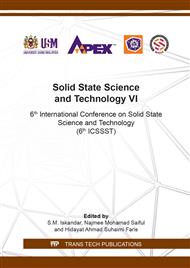[1]
R. Ramaraghavulu and S. Buddhudu, Analysis of structural, thermal and dielectric properties of LiTi2(PO4)3 ceramic powders,, Ceram. Int., vol. 37, p.3651–3656, (2011).
DOI: 10.1016/j.ceramint.2011.06.025
Google Scholar
[2]
G. X. Wang, D. H. Bradhurst, S. X. Dou, and H. K. Liu, LiTi2(PO4)3 with NASICON-type structure as lithium-storage materials,, J. Power Sources, vol. 124, no. 1, p.231–236, (2003).
DOI: 10.1016/s0378-7753(03)00609-8
Google Scholar
[3]
T. Savitha, S. Selvasekarapandian, C. S. Ramya, M. S. Bhuvaneswari, and P. C. Angelo, Electrical conduction and relaxation mechanism in Li2AlZr[PO4]3,, J. Mater. Sci., vol. 42, p.5470–5475, (2007).
DOI: 10.1007/s10853-006-0983-x
Google Scholar
[4]
L. Vijayan and G. Govindaraj, Structural and electrical properties of high-energy ball-milled NASICON type Li1.3Ti1.7Al0.3(PO4) 2.9(VO4)0.1 ceramics,, J. Phys. Chem. Solids, vol. 72, no. 6, p.613–619, (2011).
DOI: 10.1016/j.jpcs.2011.02.001
Google Scholar
[5]
A. S. Best, P. J. Newman, D. R. MacFarlane, K. M. Nairn, S. Wong, and M. Forsyth, Characterisation and impedance spectroscopy of substituted Li1.3Al0.3Ti1.7(PO4)3−x(ZO4)x (Z=V, Nb) ceramics,, Solid State Ionics, vol. 126, no. 1, p.191–196, (1999).
DOI: 10.1016/s0167-2738(99)00212-x
Google Scholar
[6]
D. H. Kothari, D. K. Kanchan, and P. Sharma, Electrical properties of Li-based NASICON compounds doped with yttrium oxide,, Ionics (Kiel)., vol. 20, no. 10, p.1385–1390, (2014).
DOI: 10.1007/s11581-014-1087-2
Google Scholar
[7]
A. S. Best, M. Forsyth, and D. R. MacFarlane, Stoichiometric changes in lithium conducting materials based on Li1+xAlxTi2-x(PO4)3: Impedance, X-ray and NMR studies,, Solid State Ionics, vol. 136–137, p.339–344, (2000).
DOI: 10.1016/s0167-2738(00)00493-8
Google Scholar
[8]
M. D. Migahed, M. Ishra, T. Fahmy, and A. Barakat, Electric modulus and AC conductivity studies in conducting PPy composite films at low temperature,, J. Phys. Chem. Solids, vol. 65, no. 6, p.1121–1125, (2004).
DOI: 10.1016/j.jpcs.2003.11.039
Google Scholar
[9]
K. D. S. M. 2 A. H. Naik 1, N. V. Thakkar1, S. R. Dharwadkar 1* and and V. Venugopal, Microwavve Assisted A H Naik 2.pdf., Journal of Thermal Analysis and Calorimetry, p.707, (2004).
Google Scholar


